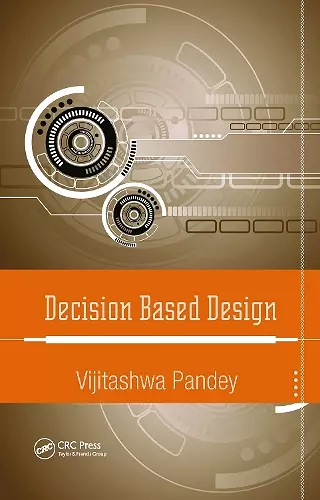Decision Based Design
Format:Paperback
Publisher:Taylor & Francis Ltd
Published:31st Mar '21
Currently unavailable, and unfortunately no date known when it will be back
This paperback is available in another edition too:
- Hardback£130.00(9781439882320)

In a presentation that formalizes what makes up decision based design, Decision Based Design defines the major concepts that go into product realization. It presents all major concepts in design decision making in an integrated way and covers the fundamentals of decision analysis in engineering design. It also trains engineers to understand the impacts of design decision. The author teaches concepts in demand modeling and customer preference modeling and provides examples. This book teaches most fundamental concepts encountered in engineering design like: concept generation, multiattribute decision analysis, reliability engineering, design optimization, simulation, and demand modeling.
The book provides the tools engineering practitioners and researchers need to first understand that engineering design is best viewed as a sequence of decisions made by the stakeholders involved and then apply the decision based design concepts in practice. It teaches fundamental concepts encountered in engineering design, such as concept generation, multiattribute decision analysis, reliability engineering, design optimization, simulation, and demand modeling.
This book helps students and practitioners understand that there is a rigorous way to analyze engineering decisions taking into consideration all the potential technical and business impacts of their decisions. It can be used in its entirety to teach a course in decision based design, while selected chapters can also be used to cover courses in subdisciplines that make up decision based design.
"… provides information about many topics related to decision-based design and explains them thoroughly. … emphasizes that decision analysis is valuable because it can help decision-makers make decisions consistent with their preferences. In general, the text combines discussions that provide background and implications, mathematical details, and illustrative examples. The level of mathematics used is appropriate for engineering students."
—Jeffrey W. Herrmann, University of Maryland, College Park, USA
"A new, rigorous approach to engineering design is presented. Those companies that will adopt this methodology and apply it in product development will gain a competitive edge."
—Efstratios Nikolaidis, The University of Toledo, Ohio, USA
"… a welcome new addition to the offerings on decision theory as applied to engineering design and systems engineering. It provides a comprehensive overview and practical guidance for how to formulate and solve design problems from a decision-theoretic perspective. Although the mathematical rigor could be improved in some chapters, the book provides useful guidance to students and professionals interested in improving their understanding of decision-based design."
—Chris Paredis, Georgia Institute of Technology, Atlanta, USA
"… provides information about many topics related to decision-based design and explains them thoroughly. … emphasizes that decision analysis is valuable because it can help decision-makers make decisions consistent with their preferences. In general, the text combines discussions that provide background and implications, mathematical details, and illustrative examples. The level of mathematics used is appropriate for engineering students."—Jeffrey W. Herrmann, University of Maryland, College Park, USA
"A new, rigorous approach to engineering design is presented. Those companies that will adopt this methodology and apply it in product development will gain a competitive edge."—Efstratios Nikolaidis, The University of Toledo, Ohio, USA
"… a welcome new addition to the offerings on decision theory as applied to engineering design and systems engineering. It provides a comprehensive overview and practical guidance for how to formulate and solve design problems from a decision-theoretic perspective. Although the mathematical rigor could be improved in some chapters, the book provides useful guidance to students and professionals interested in improving their understanding of decision-based design."—Chris Paredis, Georgia Institute of Technology, Atlanta, USA
ISBN: 9780367783754
Dimensions: unknown
Weight: 453g
284 pages